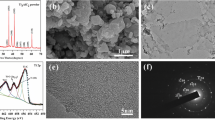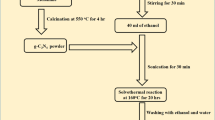Abstract
Forming BiOBrxI1−x solid solution structural photocatalyst has been regarded as an efficient method for photocatalytic property of bismuth oxyhalides (Bi–O–X, X = Br, Cl and I) photocatalysts. In this work, in order to further improve the photocatalytic property of BiOBrxI1−x, MXene Ti3C2Tx material was used to construct heterostructural photocatalyst with BiOBrxI1−x. The MXene Ti3C2Tx was achieved by etching the Ti3AlC2 with HF and its layered structure was firstly confirmed by X-ray diffraction, scanning electron microscope and high resolution transmission electron microscope. The BiOBr0.5I0.5/MXene Ti3C2Tx (BOT-5) composite was achieved through a simple synthesis process and its heterostructure was determined by efficient characterizations. Through degradation experiments, the improved photocatalytic degradation property for Rhodamine B (RhB) and phenol of BOT-5 was observed and its excellent chemical stability was also verified meanwhile. The photocatalytic mechanism of BOT-5 was further explored in this work. Through efficient experimental strategies, the enhanced carrier photocatalysis of BOT-5 together with its inhibited extinction photocatalysis was verified. Benefiting from the enhanced carrier photocatalysis of BOT-5, more superoxide and hydroxyl radicals were generated and supported its enhanced photocatalytic degradability.







Similar content being viewed by others
References
Y. Bai, L. Ye, W. Li, X. Shi, P. Wang, W. Bai, P. Wong, g-C3N4/Bi4O5I2 heterojunction with I3−/I− redox mediator for enhanced photocatalytic CO2 conversion. Appl. Catal. B 194, 98–104 (2016)
K. Zhang, C. Liu, F. Huang, C. Zheng, W. Wang, Study of the electronic structure and photocatalytic activity of the BiOCl photocatalyst. Appl. Catal. B 68, 125–129 (2006)
F. Jie, Y. Tian, B. Chang, F. Xi, X. Dong, BiOBr–carbon nitride heterojunctions: synthesis, enhanced activity and photocatalytic mechanism. J. Mater. Chem. 22, 21159–21166 (2012)
M. Yan, L. Wen, Z. Wang, D. Cao, Y. Fang, L. Yong, Building of anti-restack 3D BiOCl hierarchitecture by ultrathin nanosheets towards enhanced photocatalytic activity. Appl. Catal. B 176, 331–337 (2015)
S. Meng, W. Wang, L. Zhang, Preparation of BiOBr lamellar structure with high photocatalytic activity by CTAB as Br source and template. J. Hazard. Mater. 167, 803–809 (2009)
L. Ye, L. Zan, L. Tian, T. Peng, J. Zhang, The 001 facets-dependent high photoactivity of BiOCl nanosheets. Chem. Commun. 47, 6951–6953 (2011)
H. Cheng, B. Huang, P. Wang, Z. Wang, Z. Lou, J. Wang, X. Qin, X. Zhang, Y. Dai, In situ ion exchange synthesis of the novel Ag/AgBr/BiOBr hybrid with highly efficient decontamination of pollutants. Chem. Commun. 47, 7054–7056 (2011)
D. Zhang, M. Wen, B. Jiang, G. Li, J.C. Yu, Ionothermal synthesis of hierarchical BiOBr microspheres for water treatment. J. Hazard. Mater. 211–212, 104–111 (2012)
Y. Bai, L. Ye, T. Chen, L. Wang, X. Shi, X. Zhang, D. Chen, Facet-dependent photocatalytic N2 fixation of bismuth-rich Bi5O7I nanosheets. ACS Appl. Mater. Inter. 8, 27661–27668 (2016)
L. Ye, C. Han, Z. Ma, Y. Leng, J. Li, X. Ji, D. Bi, H. Xie, Z. Huang, Ni2P loading on Cd0.5Zn0.5S solid solution for exceptional photocatalytic nitrogen fixation under visible light. Chem. Eng. J. 307, 311–318 (2017)
Y. Lei, G. Wang, P. Guo, H. Song, The Ag-BiOBrxI1-x composite photocatalyst: preparation, characterization and their novel pollutants removal property. Appl. Surf. Sci. 279, 374–379 (2013)
Q. Zhao, X. Liu, Y. Xing, Z. Liu, C. Du, Synthesizing Bi2O3/BiOCl heterojunctions by partial conversion of BiOCl. J. Mater. Sci. 52, 2117–2130 (2017)
J. Cao, B. Xu, B. Luo, H. Lin, S. Chen, Novel BiOI/BiOBr heterojunction photocatalysts with enhanced visible light photocatalytic properties. Catal. Commun. 13, 63–68 (2011)
Y. Bai, X. Shi, P.Q. Wang, H. Xie, L. Ye, Photocatalytic mechanism regulation of bismuth oxyhalogen via changing atomic assembly method. ACS Appl. Mater. Interfaces 9, 30273–30277 (2017)
X. Shi, P. Wang, L. Wang, Y. Bai, H. Xie, Y. Zhou, L. Ye, Change in photocatalytic NO removal mechanisms of ultrathin BiOBr/BiOI via NO3- adsorption. Appl. Catal. B 243, 322–329 (2019)
Y. Bai, X. Shi, P. Wang, L. Wnag, K. Zhang, Y. Zhou, H. Xie, J. Wang, L. Ye, BiOBrxI1−x/BiOBr heterostructure engineering for efficient molecular oxygen activation. Chem. Eng. J. 365, 34–42 (2019)
V. Vaiano, M. Matarangolo, J. Murcia, H. Rojas, J. Navío, M. Hidalgo, Enhanced photocatalytic removal of phenol from aqueous solutions using ZnO modified with Ag. Appl. Catal. B 225, 197–206 (2018)
R. Wang, D. Ren, S. Xia, Y. Zhang, J. Zhao, Photocatalytic degradation of bisphenol A (BPA) using immobilized TiO2 and UV illumination in a horizontal circulating bed photocatalytic reactor (HCBPR). J. Hazard. Mater. 169, 926–932 (2009)
A. Ali, A. Belaidi, S. Ali, M. Helal, K. Mahmoud, Transparent and conductive Ti3C2Tx (MXene) thin film fabrication by electrohydrodynamic atomization technique. J. Mater. Sci.: Mater. Electron. 27, 5440–5445 (2016)
C. Shi, M. Beidaghi, M. Naguib, O. Mashtalir, Y. Gogotsi, S. Billinge, Structure of nanocrystalline Ti3C2 MXene using atomic pair distribution function. Phys. Rev. Lett. 29, 1211–1215 (2014)
T. Zhang, L. Pan, H. Tang, F. Du, Y. Guo, T. Qiu, J. Yang, Synthesis of two-dimensional Ti3C2 MXene using HCl + LiF etchant: enhanced exfoliation and delamination. J. Alloys Compd. 695, 818–826 (2016)
K. Rasool, M. Helal, A. Ali, C. Ren, Y. Gogotsi, K. Mahmoud, Antibacterial activity of Ti3C2Tx MXene. ACS Nano 10, 3674–3684 (2016)
X. An, W. Wang, J. Wang, H. Duan, J. Shi, X. Yu, The synergetic effects of Ti3C2 MXene and Pt as co-catalysts for highly efficient photocatalytic hydrogen evolution over g-C3N4. Phys. Chem. Chem. Phys. 20, 11405–11411 (2018)
Y. Sun, D. Jin, Y. Sun, X. Meng, Y. Gao, Y. Dall Agnese, G. Chen, X. Wang, g-C3N4/Ti3C2 MXene composite with oxidized surface groups for efficient photocatalytic hydrogen evolution. J. Mater. Chem. A 6, 9124–9131 (2018)
C. Liu, Q. Xu, Q. Zhang, Y. Zhu, M. Ji, Z. Tong, W. Hou, Y. Zhang, J. Xu, Layered BiOBr/Ti3C2 MXene composite with improved visible-light photocatalytic activity. J. Mater. Sci. 54, 2458–2471 (2019)
X. Guo, X. Xie, S. Choi, Y. Zhao, G. Wang, Sb2O3/MXene(Ti3C2) hybrid anode materials with enhanced performance for sodium-ion batteries. J. Mater. Chem. A 5, 12445–12452 (2017)
H. Liu, Y. Su, Z. Chen, Z. Jin, Y. Wang, Graphene sheets grafted three-dimensional BiOBr0.2I0.8 microspheres with excellent photocatalytic activity under visible light. J. Hazard. Mater. 266, 75–83 (2014)
L. Sun, L. Xiang, X. Zhao, C. Jia, J. Yang, Z. Jin, X. Cheng, W. Fan, Enhanced visible-light photocatalytic activity of BiOI/BiOCl heterojunctions: key role of crystal facet combination. ACS Catal. 5, 3540–3551 (2015)
Y. Wu, H. Wang, W. Tu, Y. Liu, Y. Tan, X. Yuan, J. Chew, Quasi-polymeric construction of stable perovskite-type LaFeO3/g-C3N4 heterostructured photocatalyst for improved Z-scheme photocatalytic activity via solid p-n heterojunction interfacial effect. J. Hazard. Mater. 347, 412–422 (2018)
L. Ye, X. Jin, C. Liu, C. Ding, H. Xie, K.H. Chu, P. Wong, Thickness-ultrathin and bismuth-rich strategies for BiOBr to enhance photoreduction of CO2 into solar fuels. Appl. Catal. B 187, 281–290 (2016)
L. Ye, W. Hui, X. Jin, Y. Su, D. Wang, H. Xie, X. Liu, X. Liu, Synthesis of olive-green few-layered BiOI for efficient photoreduction of CO2 into solar fuels under visible/near-infrared light. Sol. Energy Mater. Sol. Cells 144, 732–739 (2016)
A. Moya, A. Cherevan, S. Marchesan, P. Gebhardt, M. Prato, D. Eder, J. Vilatela, Oxygen vacancies and interfaces enhancing photocatalytic hydrogen production in mesoporous CNT/TiO2 hybrids. Appl. Catal. B 179, 574–582 (2015)
M. Ou, D. Fan, Z. Wei, Z. Wu, Efficient visible light photocatalytic oxidation of NO in air with band-gap tailored (BiO)2CO3-BiOI solid solutions. Chem. Eng. J. 255, 650–658 (2014)
Y. Nosaka, A.Y. Nosaka, Generation and detection of reactive oxygen species in photocatalysis. Chem. Rev. 117, 11302–11336 (2017)
H. Li, J. Shang, H. Zhu, Z. Yang, Z. Ai, L. Zhang, Oxygen vacancy structure associated photocatalytic water oxidation of BiOCl. ACS Catal. 6, 8276–8285 (2016)
H. Wang, D. Yong, S. Chen, S. Jiang, X. Zhang, W. Shao, Q. Zhang, W. Yan, B. Pan, Y. Xie, Oxygen vacancy mediated exciton dissociation in BiOBr for boosting charge-carrier-involved molecular oxygen activation. J. Am. Chem. Soc. 14, 1760–1766 (2018)
S. Cao, B. Shen, T. Tong, J. Fu, J. Yu, 2D/2D heterojunction of ultrathin MXene/Bi2WO6 nanosheets for improved photocatalytic CO2 reduction. Adv. Funct. Mater. 21, 1800136 (2018)
C. Jing, B. Xu, H. Lin, B. Luo, S. Chen, Chemical etching preparation of BiOI/BiOBr heterostructures with enhanced photocatalytic properties for organic dye removal. Chem. Eng. J. 185–186, 91–99 (2012)
Acknowledgements
This work is supported by National Natural Science Foundation of China (Grant No. 51702270), the Scientific Research Starting Project of SWPU (Grant No. 2015QHZ001), Young Scholars Development Fund of SWPU (Grant No. 201499010100), Open Fund (Grant No. 201601) of State Key Laboratory of Physical Chemistry of Solid Surfaces (Xiamen University).
Author information
Authors and Affiliations
Corresponding author
Additional information
Publisher's Note
Springer Nature remains neutral with regard to jurisdictional claims in published maps and institutional affiliations.
Electronic supplementary material
Below is the link to the electronic supplementary material.
Rights and permissions
About this article
Cite this article
Shi, X., Wang, P., Lan, L. et al. Construction of BiOBrxI1−x/MXene Ti3C2Tx composite for improved photocatalytic degradability. J Mater Sci: Mater Electron 30, 19804–19812 (2019). https://doi.org/10.1007/s10854-019-02346-1
Received:
Accepted:
Published:
Issue Date:
DOI: https://doi.org/10.1007/s10854-019-02346-1




